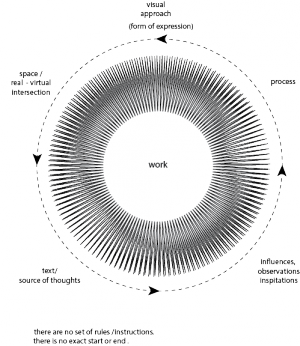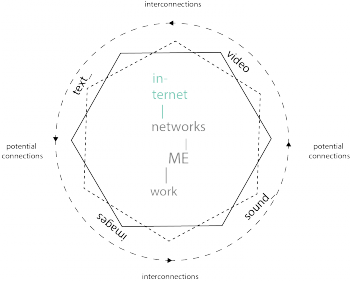SELF - directed
Self-directed research essay = 1000-1500 words
The aim of this exercise is:
(1) to further articulate your practice and to discuss it within a broader cultural and historical context
(2) to identify and articulate a methodology
Some of you have already made progress in producing texts which fulfill the above ends.
In the second year, when you produce your Final Project Proposal, then it will be necessary to demonstrate the ability to do the above.
Guidelines: The aim of this assignment is to use description of your work as a way of identifying and articulating your method. Describing first what and then how and why you make work often leads to discussions of the works context (what work is similar to the work you describe; what are the key ideas the work deals with) . The theoretical elements of the texts you write should therefore emerge from, and have a very clear connection with, the work you are making. For this experiment I am asking you to follow the method outlined above so that you can begin to reflect and write quite deeply about the work you are making. A second method you will find useful is to draw on annotations of texts you have read which have a particular relation to the work you make.
Key themes
Self-directed research essay = 1500 words
identify and articulate practice/ methodology
and discuss it within a broader cultural and historical context
description of recent work
what how why - context
key themes
how texts already produced might be useful (descriptions of work, or annotations for instance)
contextualizing texts (art work or literature) - annotations
Abstract/ Intro/ Text/ Conclusion
(Note on mode of address: imagine you are writing for a reader who is known to you, a peer or colleague. What needs to be explained to them for them to understand what you do?)
Abstract
"It is the vanishing point of now-here is the same time a no-where."
Describe recent work
"The pulse of RealTime orients the life of every citizen.
Eating, resting, going to work, getting married-every act is tied to RealTime.
And every act leaves a trace of data - a footprint in the snow of noise.
The New Machine monitors these data traces to ensure that all is well."
- Urban planting is a social intervention in public space or an action cease to provoke a reaction.
I placed a plant —a common interior feature out of the context at the Rotterdam Central metro station.
I intentionally positioned it in the middle of the sidewalk where it frequently became an object of illumination by numerous fluorescent lights and CCTV cameras. I found myself and my non-depict form of intervention in the spotlight: overexposed, monitored and investigated. Thereby neither the absurdity of the object by itself, nor the audience’s bare reaction were central; instead it was the authority’s (in particular the security’s) response that became the main event of action.
I found myself interested in this anonymous or depersonalized, transit aspect of the city.
The intervention was provoked by analysis on rhythm of space and time and how the "rhythm" in this sense "the enclose system" can be triggered, changed and even glitched.
Nevertheless the project reflects upon to Foucauldian notion that we are constantly exposed to surveillance.
Under numbers of CCTV cameras we have become an ultimate object of observation, monitoring, targeting and recording.
Therefore I link my attempt to interfere with a system, questioning the aspect of enclosure spaces to “Faceless project” where interdisciplinary media artists Manu Luksch & Mukul Patel investigate surveillance, privacy, regulations of public space.
"Faceless" is described as a CCTV si-fi fairy-tale narrative or visual essay which surfs as a continues journey of figures moving into the public space. The video consists of CCTV diverse footage, where the faces of the protagonists are replaced by dots surpassed by an abstract voiceover.
Faceless project is a poetic, philosophical and artistic interpretation of the idea of mass surveillance. It explores the blurred boundaries between private-public, The machine - the machine operator and time – RealTime interconnection. The notion of the RealTime orients the life of every citizen. "The Machine" as - the ultimate tool, which operates in an invisible, unethical level – tracing data in RealTime – the current time of being.
reading_references:
"Postscript on the societies of control" by Gilles Deleuze, 1992
visual_references:
Faceless project – Voiceover (Manu Luksch & Mukul Patel), 2007
- "Disrupted practices" is an representation of an on going visual search.
The site documents series of experiments with an analog & digital signal so called visual discoveries, found or appropriated.
exploring the field of personal expressions/ interpretations.
It aims to simply track the actual process – now in a form of documentation,
which will take a form( optional form_1, form_2, form_3 ) depends on the the chosen formula of present.
Due to certain misleading in the glitch research which took more or less a form of an overview of current practices and theories I took more [a}side/ of the observer, interpreter where my position is still unclarified. Once I enter the category, specified as "Glitch, glitch art, datamoshing, image bending the category took control over me and my practice where I immerse myself in playing a role of the category. I felt completely disconnected of glitch theory, community and was overloaded with 'glitch ART' or everything categorized, tagged as such.
What links here:
- 'The work of art in the age of digital recombination' - Jos de Mul
- "Online video Aesthetics or the Art of Watching Databases" Networks without cause Geert Lovink, (to write annotation)
Draft on Methodologies
The process as unique, non repetitive
multiple paths, multiple plots, multiple processes.
The diagrams above is an attempt to visualize and analyze my methodology or how I create/ articulate an art work?
My methodology is a circle an infinitive form of on going search.
There are no exact rules steps to be executed now follow step_1, step2 then step#
in these terms is extremely difficult to set up certain rules, start or end point there are multiple starts and ends of a work.
My methods of work is often connected to visual approach or already predefined “pictorial” of the
Often the process based leads to create or shift into another direction or ultimately become the actual work.
Text source of thoughts (research based) is influential texts I would go forward and backwards referring or denying.
Howsoever this method could be blocking or liberating at the same time.
The text evaluates the work and structuralize in coherent way.
Space real-virtual intersections – this is the place I still define
To what extend I will embed, incorporate "the online" in my practice.
Can it takes more complex form of online-offline back to online ( which does not necessary mean "net art" practices)
Contextualize image use already existing source – combine, recombine, compare, match, mismatch and can they lead to different
interpretations?
I will stay offline and work with time-based media / images create an experience, perception?


“the hexagonal rooms are a necessary form of absolute space or, at least, of our intuition of space.”
“The library of Bebel” Jorge Luis Borges
conclusion???
contextualizing texts
- Social networks as a playground/ interface of mass self-performance. (you tube seminar)
"All the world is a stage, and we are mere actors". ... Shakespeare
- The work of art in the age of digital recombination by Joe de Mul
"The art is here and now”. In the past the work of art was characterized with uniqueness, certain historical value of the time and space it was created. Moreover it was subject of ritual cult. According to Benjamin’s theory in the age of mechanical reproduction the cult value of the art work gradually vanished replaced by the exhibition value. With the introduction of print, photography and film the work of art become accessible – copied – reproduced, spread –expanded, shared – cultivate. All of which leaded to certain lost of the authenticity of the work or the “aura“. ”To an ever greater degree the work of art reproduced becomes the work of art designed for reproducibility.” However in the present digital age Joe de Mul shares a belief that the work of Art is a subject on vast on-going databases, where elements are combined, recombined, transformed and manipulated. Database is simply defined as collection of items that is ordered in one way or another then in computing context – database is presented as a structured collection of data records, stored in a computer, so that it can be consulted to answer queries. Databases apply certain flexibility, which enable the work of Art of being constantly and infinitely modified/recombined.
- "Online video Aesthetics or the Art of Watching Databases" Networks without a cause, Geert Lovink
- " Networks without a cause, Geert Lovink
Ex.You Tube as a sculpture
Why won't this video load?
The artist Constant Dollars made a physical sculpture out of the standard loading gif and then he uploaded it back to you tube, where comments why the video does not load.
